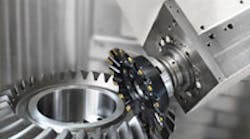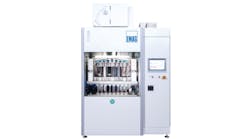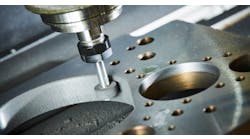The patent-pending uP-Gear process — co-developed by Heller Machine Tools and Voith Turbo — is aimed at manufacturers of vehicles, machines, or machine components, that machine large gears in low volume.
Together with transmission manufacturer Voith Turbo AG, Heller Machine Tools has developed a process that it reports will enhance the productivity of pre-milling and gear milling operations performed on a single 5-axis machining center. Both companies have applied for a patent on the jointly developed process.
Manufacturers of gear components and bevel gears need alternatives to traditional hobbing processes for larger gears. At the same time, machine tool flexibility is gaining importance because many gear-makers can no longer afford to depend on dedicated machine tools just to produce gears. They want the capability and flexibility that a multi-purpose machining center offers.
The patent-pending uP-Gear technology process is aimed at manufacturers of vehicles, machines, or machine components that machine large gears in low volumes, along with other machining tasks.
In recent years, gear milling has become more interesting to some machine tool builders who see it as an efficient use of a five-axis machining center’s existing capability, bringing opportunities for some operators to develop applications for their installations. According to Heller, gear milling is a way to maximize the potential of its 5-axis machining centers, which range from its new F series machines to its heavy-duty MCH-C series.
Heller emphasizes that builders of traditional gearmaking equipment continue to concentrate on special-purpose machines and tools dedicated to gear machining, but that manufacturers of machining centers can provide complete machining for a range of applications, as well as solutions for gear modeling using special software. The software makes it possible for users to generate ideal gear geometry from which the gearmaking process can be developed.
Gear data drives the program
Technical literature on gear technology claims there is no comprehensive mathematical model for bevel gear tooth systems. Therefore, every CAD model used for the CAD/CAM process is an approximated model. Traditional gear cutting machines are based on a specific machine structure with corresponding kinematics. The machine generates the appropriate tooth shape based on the setting parameters entered into the machine.
The uP-Gear process is a productive solution for workpieces of different sizes, starting from gear module 4: the smaller Heller 5-axis machining center model FP 2000 for diameters of up to 720 mm; the larger model FP 4000 for diameters of up to 900mm; model MCH-C with HSK100-spindle taper for diameters of up to 1800mm; and a new range of machines for diameters up to 3,000mm.
Heller’s approach is different, although it resembles the hobbing process: the gear parameters specified on the drawing are directly input into the machine control. The control then uses the data to generate the 5-axis paths for roughing and finishing in real time. As a result, no mathematically accurate 3D geometry model is required. Instead, the pre-defined gear data from the drawing are used.
The measuring machine reports compensation data that can be directly entered in the machine control for processing. Another major benefit of this approach is that current tool data, such as tool wear, can be incorporated into the ongoing process in real time. As a result, precision is enhanced. Also, the process provides users with flexibility and productivity without creating a new dependency on special software.
Along with tooth space machining, Heller provides a process solution for pre-milling/turning of blanks. Complete pre-machining of external and internal contours is possible in the first setup, while tooth milling takes place in the second. Specially adapted NC cycles have been developed to facilitate process control. As a result, the complete workpiece can be machined on a single machine.
New cutter raises productivity 300%
There are other 5-axis machining centers are said to be equally versatile and suited for gear milling when programmed accordingly: using an end milling cutter, for instance, provides high flexibility.
But, according to Dr. Hannes Zipse, Heller’s business development manager, the method is not particularly efficient or productive: “We operate in fields with high chip removal rates and aim to achieve the same in gear milling. We co-operated with Sandvik Coromant to develop a customized crown-milling cutter with indexable inserts, resulting in a type of hob. This had a major role in increasing productivity by the factor of three, compared to conventional methods. The wider the tooth space, the more productive we will be.”
The level of productivity essentially depends on the static and dynamic stability of the machine. For Reinhold Siegler, Heller’s head of technology development this is the most important point of all: “Very compact clamping is essential. That means that the position of the pallet chuck in the Heller solution is very close to the upper pallet edge to enable deep clamping of the gear or bevel gear.
“Additionally, our extremely robust spindles and highly rigid machine elements plus the use of short tools designed for roughing are key benefits. For this reason, we achieve higher productivity in the roughing operation than can a vertical machining process,” he said.
Versatilty for OEMs, larger manufacturers
The new process is a productive solution for workpieces of different sizes, starting from gear module 4: the smaller Heller 5-axis machining center model FP 2000 for diameters of up to 720 mm; the larger model FP 4000 for diameters of up to 90 0mm; model MCH-C with HSK100-spindle taper for diameters of up to 1800 mm; and a new range of machines for diameters up to 3,000mm.
Despite the time-consuming changeover required, the use of a special-purpose machine is still more efficient for manufacturing small gears produced in high volumes. Therefore, the Heller/Voith process is not directly aimed at classic contract gear manufacturers producing a small variety of workpiece types in high volumes.
Instead, the Heller solution is for system suppliers — manufacturers of vehicles, machines or machine components — that can also use the machine for other machining tasks. The process also will be of interest to gearbox manufacturers, whose products include complete assemblies. In particular, this applies to large gears since the machines and the technology provided by Heller are suited for a wide range of machining tasks and provide the additional benefit of enabling efficient machining of gears and bevel gears.
Kenneth Sundberg, global business development manager at Sandvik Coromant, considers this a very interesting market opportunity: “The recent past has shown that the market continually comes up with machining solutions for gear components and bevel gears. For this reason, Sandvik Coromant has modified standard tools and incorporated new developments in the milling cutters. We are extremely satisfied with the machining results achieved so far. In a second step, we will focus on hard-milling processes.
“Although it is possible to use solid carbide end milling cutters for this purpose, we and Heller believe that using special crown milling cutters and side milling cutters will provide higher productivity and economic efficiency,” he concluded.






